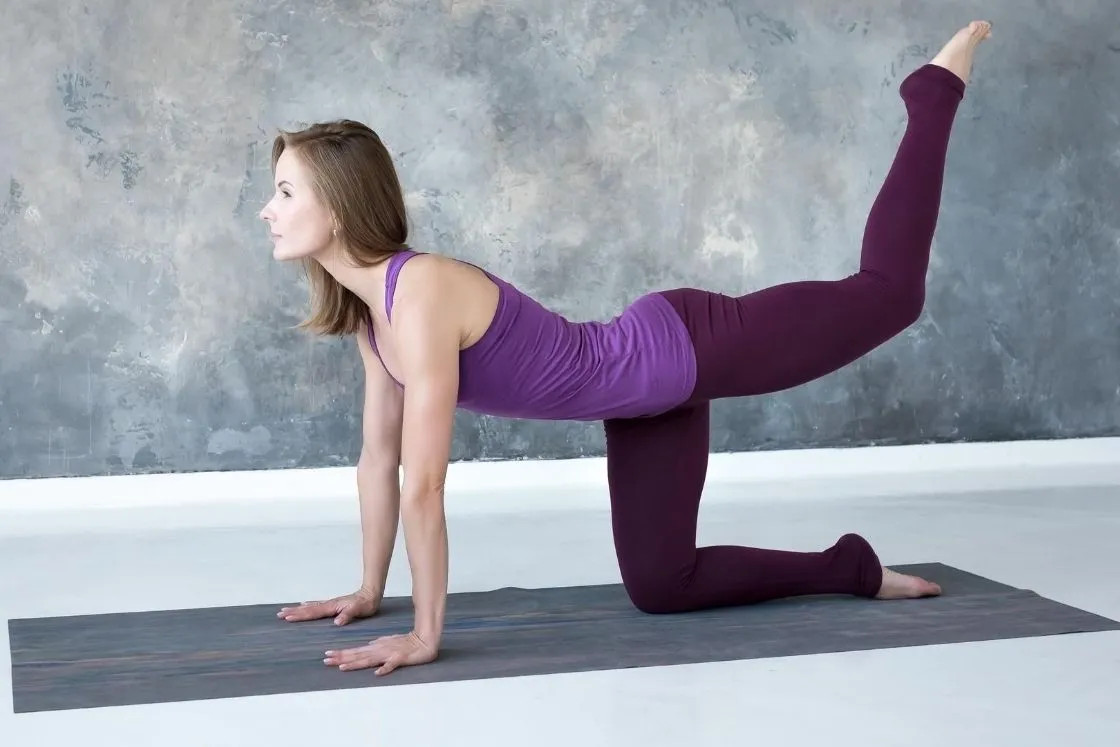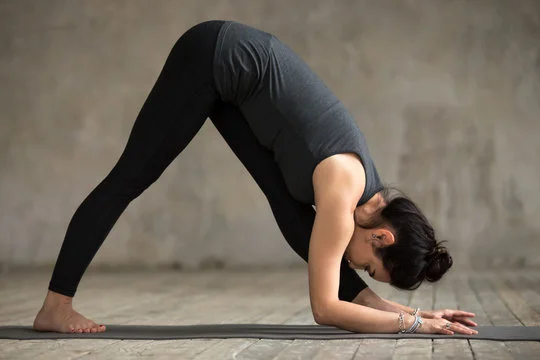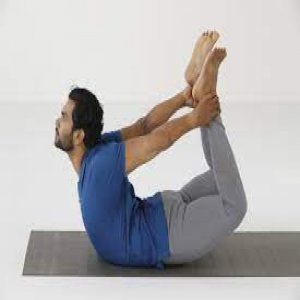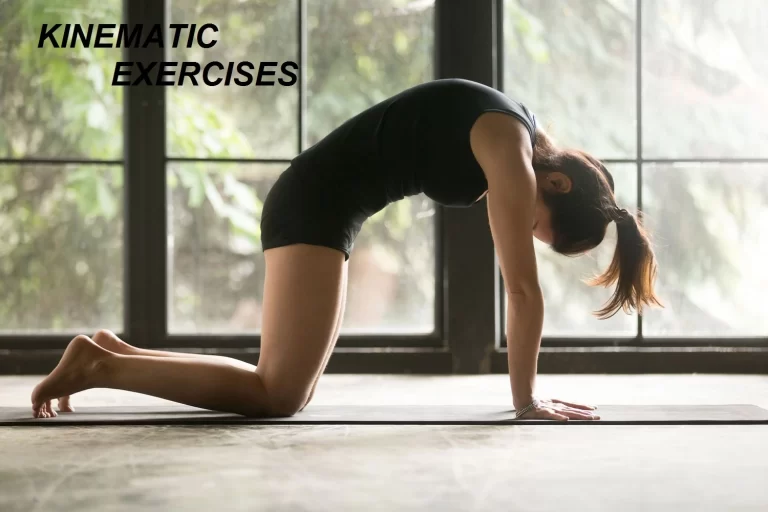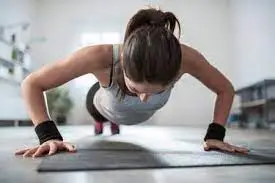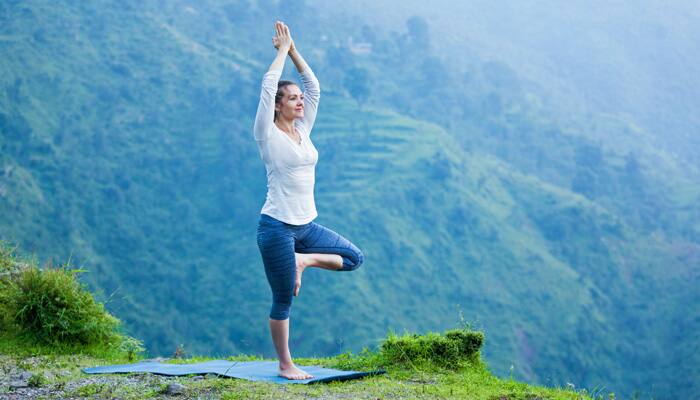Vyaghrasana (Tiger Position)
What is Vyaghrasana (Tiger Position)?
In Sanskrit, it’s known as Vyaghrasana, Vyaghra means Tiger. Therefore the name Vyaghrasana (Tiger Position). When a tiger wakes up across rest or feels drained, then to strengthen its full body, the tiger stretches from the anterior legs to the back. Vyaghrasana (pronounced vyAa-gHrAa-Suh-nuh) is the right choice between yoga positions to methodically demand yourself and attain perfect balance.
Following the same stretch, in tiger position yoga, we lift a leg in a tabletop position and pull it ahead. The same leg goes down below the hips and stretches forward to extend the forehead. It allows convex-concave stretch to the spine. The Tiger position is the best stretching workout for the spine which permit hips and thighs to open at their maximum. So it’s most valuable for persons who are in a desk job and have accordant lower back pain.
This asana is a learner series, balancing, and backbend position where you will need to hold the body equally in a tabletop position. It is related to cat-cow stretch but on one leg and one hand (in its variation). The body is stretched deep and is in contrast to that of a tiger stretching its body when it wakes up. This the position is done on fours where the spine is stretched to the maximum giving the best opening to the hips and the thighs.
What are the Health Benefits of Vyaghrasana (Tiger Position)?
Adjustment plays the best role during the exercise of this position. The position of the arms just under the shoulders, the similar distance between the arms and the knees and also connecting both the knees and the palms. Once this is correct, the actual benefits will be obtained. The motion of the spine should be carefully watched during this exercise of Vyaghrasana. Given under are the main benefits described.
Strengthens the muscles in the arms: As this position conducts the body to all fours, your knees, and your palms, the whole body weight falls on them. However it is important to distribute the weight of the body equally, still for learners, the full weight falls on the arms. This further upgrades the muscle strength around the elbows, wrists, and shoulders.
Strengthens the knees and the thighs: As the hip weight falls on the knees and the thighs, tightening the muscles around the knees and the thighs the exercise of this position will also upgrade muscle strength. Leaving it insecure, one would have lesser control over the body and accordingly not endure stable. Hence it is necessary to work on keeping these muscles pulled in tight. Constant attraction in the muscles make them strong and one could hold on to the posture, Vyaghrasana for extensive periods.
Opens the hips and brings about balance and flexibility: Vyaghrasana or the Tiger Position, with all the awareness at the lower abdomen and lower back, useful to open the hips to the best extent. Opening of the hips mentions the spacing off any stiffness around the hips. And while the exercise should be done even with both the legs, it will also balance the hip joint. A well-balanced hip joint takes care of the inner adjustment of the same and also upgrades the flexibility of the muscles around the hip.
Excess fat burns and tones the hips and thighs: The tightening of the gluteus during the exercise of this position along with the tightening of the thigh muscles make sure the excess fat is removed and burned out. Therefore the toning of the thighs and the hips also occurs.
The Digestive system improves and the muscles get toned: The main center during the exercise of Vyaghrasana should be at the core. While the muscles at the core help to be prised in along with the belly to obtain a great-looking posture, the internal organs around these muscles start to function totally, upgrading the digestive system. Along with the upgrading of the digestive system, the abdominal muscles obtain toned up helping to correct abdominal health.
Relieves stress around the lower back: The main benefit one obtains from the exercise of Vyaghrasana, is the evolution and contraction of the lower back muscles, while the belly is prised in deep making the breathing slow and secure. The steady motion of the muscles around the lower back reduces the stiffness and alleviates one from any kind of lower back pain or tightness.
Tones the spinal nerves: While the breathing enlarges and contracts the whole muscles around the spine, the nerves obtain sufficient prana to help healing and keeping the nerves fit. These nerves also moderate the sciatic nerves and diminish any symptoms and pains related to sciatica.
Reproductive organs get toned: The deep movement and evolution of the lower abdominal muscles, towards the side of the abdomen, which obtains the maximum stretch as the leg is lifted, obtains toned with this deep stretch. This stretch works on tightening the muscles about the vagina too, manufacturing it the best position to be exercised by women after childbirth.
A great chest opener: With variations of this position, Tiger Position, the stretch can become a magnificent chest opener, by lifting the neck upwards while still belongings on to the balance. Opening of the chest works well for healing allergies connected to asthma.
Great on the joints: The pressure at the neck, knees, ankles, shoulders, elbows, wrists, and hips helps in working on the motion of the joints. Hence it waken the body and keeps these joints flexible and fit.
Mental benefits: Energising, Confidence booster, Upgrades concentration, and focus Deliver nervous tension and feeling of stress.
Enhances Spinal flexibility: Tiger position makes the spine move in a wave-like system; This disconnects up the inter vertebral joints and also lubricate well by the spinal fluid. Hence, the spine becomes graceful and flexible.
Tones and Soothes Sciatic and Spinal Nerves: Stretching of legs after bending the back simultaneously bolster the sciatic and spinal nerves.
Activates Sacral Chakra: While Gazing upward, your back curve downward in this asana, which creates an energetic loop around the seat of the sacral chakra and balance it. A balanced sacral chakra allows your food to digest appropriately and gives you pleasure, movement, and creativity.
Strengthens Female Reproductive System: Tiger position is specially approved for Post-pregnancy women. It tones and revitalizes the female reproductive system and strengthens the muscles in this area. Therefore, it also replaces the reproductive health of women with many births.
Stimulates Abdominal Blood circulation: Lifting and lowering of the legs in this asana commitments and relaxes the abdominal area; due to the liveliness of the abdomen, the blood circulation to the abdominal muscles increases. Apart from that, the strengthened circulation; upgrade feedback from the organs of the concerning area.
Reduces Weight: Active metabolism burns off more fat around the hips, thighs, belly, and waist. Therefore, reduces weight and makes one healthy in the long run.
Relaxes the mind: Up and down motion of the head frees up the tension from the neck that assists the head. The swinging motion of the head prompts relaxation and eventually calms the mind.
Benefits for Women: Tones the pelvic area, Useful for toning after delivery. Tones the female reproductive organs and is especially beneficial for post childbirth and women with many children.
What are the Preparatory poses for Uttana Mandukasana (Stretched Up Frog Position)?
When we talk about Vyaghrasana or Tiger Position, what comes to the intelligence are the shoulders, hips, and spine. Therefore working on these ahead the exercise of Tiger Position is essential. Learning to balance the body too is another demand in Tiger Position. So given under are some of the yoga positions in series keeping in mind the about requirements.
- Bhujangasana or Cobra Position
- Salabhasana or Locust Position
- Dhanurasana or Bow Position
- Bitilasana Marjaryasana
- Cat Position (Marjariasana)
- Table Position (Bharmanasana)
- Cow Position (Bitilasana)
How to Perform Vyaghrasana (Tiger Position)?
Given under are the step-to-step method of going into the posture of Tiger Position, which is also considered a prone position. One can exercise Tiger Position standing too, but we shall now look at this position as a prone position.
Start the exercise by sitting in Vajrasana, seated on your heels and your knees.
Extending the spine upwards while seated in Vajrasana, take a few breaths and watch for the movement of the spine with the evolution and contraction of the muscles above the spine.
Move the neck towards the left and right working on opening the shoulders along with the motion of the neck.
Preliminary of the shoulder and neck muscles are important ahead of the exercise of Vyaghrasana. After replicating this for four rounds, two times on each side of the neck, conduct the body to modify.
Conduct the body forward, raising your hips off the heels and placing the palms on the ground further away from your knees anterior of you. Come onto your knees while affecting forward to place the palms on the ground. Knees should be hip distance apart and the palms are placed just under the shoulders, at shoulder width distance.
Make certain the feet are placed in line with the knees and placed on the toes. The heels are sharp upwards while the toes are placed firmly on the ground. Do not modify the feet completely on the ground.
The pressure on the toes while on the ground too acts as the best way to wake the nerves up during the posture.
Conduct the wrist firm on the ground with all the fingers touching the ground and make certain the inner palms too are touching the ground. For learners, obtaining a feel of the palms on the ground may take time as one is just learning to balance first. Once, one obtain to learn to balance the body well, the pressure of the palms on the ground becomes necessary.
Lift the chest and conduct it forward, making certain the shoulders are just above the wrists and the elbows stretched out and not twisted inwards. Lock those elbows pointing the inner elbows towards each other insides.
Once the body is in position, make certain the lower back is lifted upwards while taking the neck upwards too. Take a few breaths now, while still obtaining confidence in the balance of the body. Make certain the body weight is not totally on the knees and the wrists.
Inspire and lift the left knee off the ground and conduct it inside towards your chest, balancing carefully on your right knee and the palms and as you expire stretch it backward and lift the left thigh beyond you, as high as possible while still having the left knee twist.
The left thigh is now similar to the ground with the left toes pointed upwards. Once you have obtained confidence here, take the neck upwards and gaze up opening the chest to the maximum.
Endure the stretch at the lower left side of the abdomen and the left side of the hips. Work on slow breathing but deep, and with every inspiration tighten the belly and with every expiration enlarge the position and raise the left leg higher.
While one obtains confidence, slowly work on taking the feet pointing them towards the back of your head, and bending the ankles. Lifting the thighs high up and taking the feet deep backward about your head upgrades the posture and creates the best opening to the hips.
Balance your body in this position, checking the belly is pulled in to help keep the hips and lower back tight too. Endure in this position for about 4 breaths or longer turn on the level of exercise.
While in the position of Tiger Position, watch for the motion of the spine with inspiration and expiration and stretch the muscles around the spine to the maximum.
To deliver, inspire and conduct the left knee down and release the neck and place the left knee on the ground, in adjustment with the right knee and left wrist. While placing the left knee back to the ground make certain the adjustment of the wrists and the knees are complete. Take a few breaths here casting the neck inside to release the tensions about the shoulders.
Now inspire and lift the right knee off the ground and conduct it close to the chest inside and as you expire extend the right thigh and knee and take it beyond you conducting the right thigh collateral to the ground while the right toes are pointed upwards.
With normal breathing balance the body first and once assertive, with every expiration lift the right thigh high up and conduct the right foot close to the back of your head pointing the toes inside bending the right ankle.
Direct the neck upwards gazing up and giving room for the chest to extend. Conduct the breathing below control with the consciousness of the body too.
Watch for the stretch above the right side of the lower abdomen, along with the shoulders and the hips. With slow deep breathing hold the position for about 4 breaths or more. The motion of the spine here becomes necessary and the awareness of the same is crucial.
Balance the body in this position, Vyaghrasana, and keep the mind and the body stable by pulling in the belly to make certain the lower back and the hips endure stable and tight. Also, certify the hips endure almost collateral to the ground and turned one side.
To deliver from the position, inspire and conduct the right knee back to the ground and modify the neck. Place the right knee in adjustment with the left knee and the right wrist. Take a few breaths here, conducting the neck inside to let go of the tensions around the shoulders.
Leisurely go back to Vajrasana and modify the hips and the knees. Take a few breaths here and obtain back into Vyaghrasana for a deeper exercise.
While in the position, it is very foremost to keep the thighs tight along with the hips to conserve the position for a long period.
How to Perform Vyaghrasana (Tiger Position) by watching a Video?
What are Follow up poses for Vyaghrasana (Tiger Position)?
No Yoga position will give you benefit if the muscles that were worked at, are not given the right kind and the right number of modifications instantly. Not modifying the muscles will conduct only wear and tear, which is not what yoga is about. Therefore with the exercise of every intense yoga position, remember to conduct the body to modify permitting the muscles to contract completely. After the exercise of Vyaghrasana or Tiger Position, the best way to release the tensions above the shoulders and the lower back is to go into Prasarita Balasana and then Advasana or even Makarasana. In all the about positions, it is necessary to keep the consciousness of the breath while in the restorative position.
- Dandayamana Bharmanasana or Balancing Table Position
- Eka Hasta Vyaghrasana or One Handed Tiger Position
- Child position (Balasana)
- Shashankasan
What are the Beginners tips in Vyaghrasana (Tiger Position)?
While bowing back upward, make certain that your thigh touches the chest and your foot does not touch the floor.
Originally, due to a stiffened body, it would be hard for some promoters to complete the asana in one go; here one should know own body limits and circumvent overstraining.
What is the Breath Awareness in Vyaghrasana (Tiger Position)?
As always told, breathing is reviewed as an important component for the exercise of yoga positions and more so when the position essentials you to balance the body. So given under is a detailed note on the consciousness of the breath with the activity of the body.
Inspire: Conduct the left knee close to your chest.
Expire: Extend the left leg and take the knee stretched out beyond you extending the lower abdomen.
Inspire and Expire: While in the posture. As you inspire let out the muscles and as you expire expand the left leg beyond you deeper and stretch the left a foot deep beyond you.
Inspire: Conduct the leg back down.
Expire: Entirely modify the body conducting the neck down.
Inspire and Expire: Relaxing the body here.
Inspire: Lift the right knee close to your chest.
Expire: Expanse the right leg beyond you stretching the right thigh and lift the right foot and conduct it towards your head.
Inspire and Expire: While in the position take the posture deeper with every expiration.
Inspire and Expire: Releasing the leg and conducting the neck down and modify completely.
Inspire and Expire: Come back to Vajrasana and start slow deep breathing of inspiration and expiration modifying the spine and the shoulders completely.
What are Alignment tips for Vyaghrasana (Tiger Position)?
- Blanket: For fatherly knees, place a blanket on the floor to add an extra cushion.
- Wrist improvement: For tender wrists, place your fist on the floor rather than a flat palm.
- Balance challenge: Raise and expand the commensurable arm and leg rather than the opposite.
Alignment tips list:
- Adjust wrists below shoulders
- Adjust knees below hips
- Lengthen the neck
- Inspire and arch
- Expire and round
What are the Variations of Vyaghrasana (Tiger Position)?
Under are some common variations of the yoga position Tiger Position with the base position as Table Top Position (Bharmanasana).
As persons have differing abilities, a given yoga position may be simple for a particular person but hard for another. In such instances, as a yoga trainer you can introduce position variations to further demand a person who is finding a specific yoga position simple, or establish an easier variation of a position for the people who are locating the main position hard.
Position variations can therefore help your peoples enlarge and build further confidence in their yoga exercise no matter what their starting ability levels are. And this is where your part as a yoga trainer becomes very necessary. Under we have compiled so many position variations of Tiger Position at one place to give you purpose to plan your yoga classes as you interrelate with persons of different levels.
- Table Top position
- Balancing Table Position
- Balancing Table Position With Knee to Nose Flow
- Table Top Position variation Leg Raised
- Tiger Position Variation 1
- Table Top position Wrist Stretch
- Table Top position Knees up
- Tiger Position Table Top position Knee To Nose Flow
- Revolved Table Top position One Hand Raised
- Tiger position
- Table Top position One Legged Hip Rotation
On modifying the original tiger position, these variations can be exercised to deepen its infect.
Athena Vyaghrasana – Raised Tiger Position: This variation deepens the result of the stretch. In this, the lifted leg foot is snatched by the hand and stretched it towards the vaulting, aiming to straighten the leg in an upside-down position.
Vyaghrasana, foot touching head: In a position where the sole of the right foot faces the back of the head; Try to connect your back of the head by the right foot sole. Continue as long as you can hold your breath and then return in an above-expressed way.
Vyaghrasana, foot resting on the head: This variation is related to the first one but here foot relaxing on the floor is raised; promoters should balance their body on hands and one knee promoter.
Parsva Bakasana is a variation of Bakasana, crane position.
What are the Types of Vyaghrasana (Tiger Position)?
- One Handed Tiger Position (Eka Hasta Vyaghrasana)
One Handed Tiger Position (Eka Hasta Vyaghrasana)
What is One Handed Tiger Pose (Eka Hasta Vyaghrasana)?
Eka means One, Hasta means Hand, Vyaghra means Tiger, and Asana means Position. Eka Hasta Vyaghrasanais also known as One Handed Tiger Position.
Tiger Position mirrors the deep stretch a tiger extracts when it wakes up. It is a super luscious spinal lengthener and backbend. Use this posture to stretch out your whole anterior body, from your ankles through your thighs, abdomen, chest, and up to your throat. The one-handed variation increases the opening across your chest and into your shoulder joint. Now we added a variation with the back knee raised into a bound down dog. We also connected Simhasana Pranayama or Lion’s Breath to increase the purifying benefits of the position.
One-Handed Tiger Position (Eka Hasta Vyaghrasana) is a slightly more demanding version of Tiger Position that works on balance while providing a best stretch for the quadriceps, hip flexors, chest, and shoulders. It also upgrades spinal mobility, strengthens the back, arms, and core muscles, and upgrades focus and concentration. This position is also accepted to increase energy and restoratives in the adrenal glands. This posture is similar to Dancer position but on your knees. You stretch the same muscles, upgrade stability in the hips and also have to work hard to continue your balance. You can think of it as a starter variation.
You may also think of this beginner-to-intermediate position as a forerunner or easier alternative to the Dancer Position, as it stretches many of the same muscles while demanding balance, but is done on the hands and knees rather than standing. To make the position more comfortable, you may wish to place a bent blanket below the knees. Those with recent or chronic injuries to the back, hips, shoulders, or knees should avoid this position.
What are the Health Benefits of One-Handed Tiger Pose (Eka Hasta Vyaghrasana)?
- The Handed Tiger position stretches the shoulder and anterior of the thigh strengthens the arms and tonifies the kidneys. This posture is increases energy and stimulates the endocrine system (adrenal glands).
- Stretches the quads, hip flexors (psoas), chest, and shoulders.
- Strengthens the hips.
- Upgrades spinal mobility.
- Trains balance.
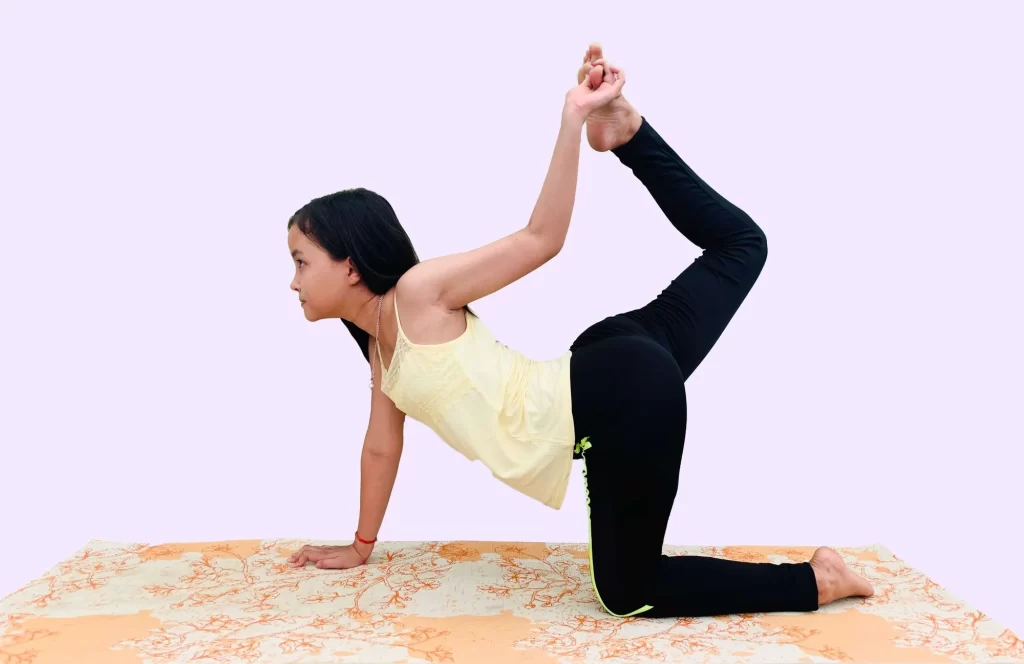
How to Perform One Handed Tiger Pose (Eka Hasta Vyaghrasana)?
From the Table position, expire reach the right foot up towards the ceiling with the knee twisted and the spine gently arching.
Staring at a point straight ahead, transfer your weight into your right hand and carefully reach the left hand to hold onto the inside of the right ankle.
With both arms straight, kindly kick the right foot into the left arm to raise the leg higher.
Breathe and hold for 2-4 breaths.
To release: Expire the arm and leg back down to the ground into the Table position.
Repeat on another side.
What are Follow up poses for One-Handed Tiger Pose (Eka Hasta Vyaghrasana):
Use one or more of the following postures to build a series ending after this position: Low Lunge, Pigeon, Table, Table Balance.
What are the Modifications and Variations in One-Handed Tiger Pose (Eka Hasta Vyaghrasana):
Modifications: Place a bent blanket below the knees to secure them from pressure and stress.
Variations: This position is a variation of the Tiger position.
What are the Contraindications for the One-Handed Tiger Pose (Eka Hasta Vyaghrasana):
- Avoid One-Handed Tiger if you have a shoulder, hip, back, or knee injury.
- Current or chronic injury to the back, shoulders, knees or hips.
What are the Modifications in Vyaghrasana (Tiger Position)?
No position becomes difficult if done with some carries and some modifications. To obtain the feel of this position for starters or for someone who needs medical attention and advice, certain modifications can be observed, some of which are given under and described.
- To start with, to avoid strain on the knees, placing blankets under the knees for extra support is a good way to start learning this position.
- The other difference is to place blankets or an extra yoga mat under the palms to obtain a better grip and to ease the pressure around the shoulders. One also obtains confidence to balance the body adequately.
- Using the wall to place the leg that is twisted for better support and yet feel the stretch could be any different for the exercise of this position. Conducting yourself close to the wall with your back facing the wall, when into the position conduct the leg that is lifted and place the shin on the wall or the feet on the wall and learn to balance the body here moderately.
- Avoid taking the neck upwards if one is not self-confident with the balance. Endure gazing forward until one learns to balance the body with confidence. For some, gazing up can also cause queasiness and make them feel dizzy. For a person who has this difficulty, one can avoid looking up.
What are the Precautions and Contraindications for the Vyaghrasana (Tiger Position)?
Precautions:
- Promoters with pain in the lower back, and injury to hips, neck, and knees in the past few months should abstain from doing the tiger position.
- In the condition of back, cervical, or Back spondylitis consult a doctor; or exercise below the guidance of a qualified teacher.
- During pregnancy, circumvent doing Vyaghrasana.
- People with a heart condition should go mild while existence guided by a skilled instructor; Hernia patients also avoid it.
- Do not power the leg too high as that may strain the muscles. Avoid overstretching the body as it may cause pain.
- If you suffer from any of these conditions avoid exercising this asana: thigh, hip, leg, back, neck or migraine, joint pain, slipped disc, weak wrists, knee
- the problem, hernia or spinal disorders.
Contraindications:
- consult this position with your general medical theorist if you have the following.
- The exercise of this position can be harmful or can cause more pain if one is suffering from severe sciatica, or in the case of slipped disc, or injury at
- the knees, Lower back, hips, Weak wrists (stand on fists instead of hands), or shoulders. Pregnant women should take complete advice and support with the exercise of this position. Avoid strong back pain or knee pain, or recent abdominal surgery. Avoid in the third trimester.
What are the dos and Don’ts in Vyaghrasana (Tiger Position)?
Do’s:
- Move the spine only as much as is snuggly
Don’ts:
- Move too fast or overstretch
What are the Therapeutic applications of Vyaghrasana (Tiger Position)?
- Postnatal
- Obesity
- Mild back pain
- Menstrual problems

